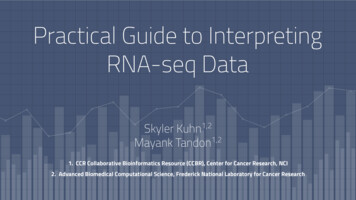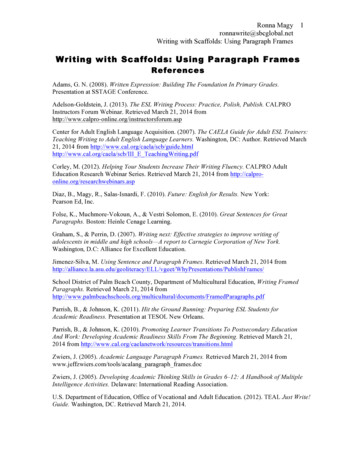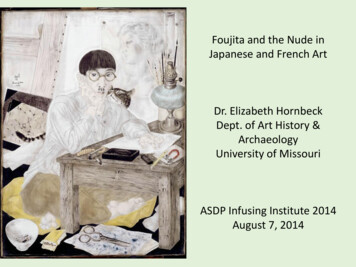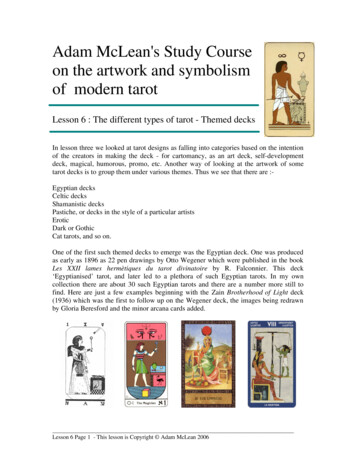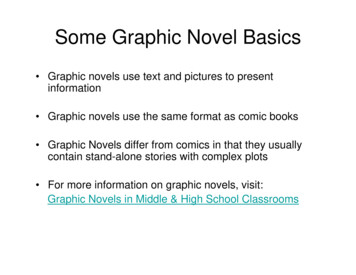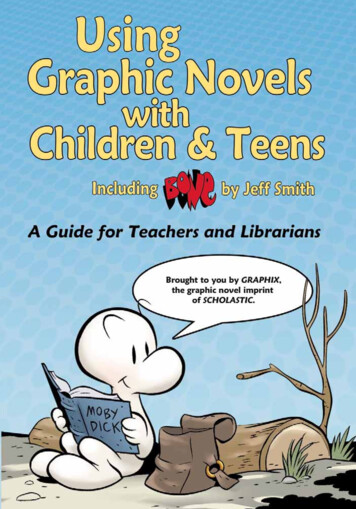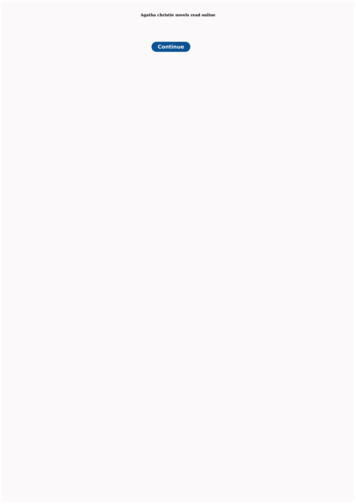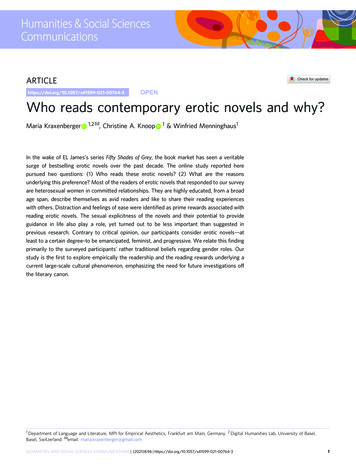
Transcription
PENWho reads contemporary erotic novels and why?1234567890():,;Maria Kraxenberger1,2 ,Christine A. Knoop1& Winfried Menninghaus1In the wake of EL James’s series Fifty Shades of Grey, the book market has seen a veritablesurge of bestselling erotic novels over the past decade. The online study reported herepursued two questions: (1) Who reads these erotic novels? (2) What are the reasonsunderlying this preference? Most of the readers of erotic novels that responded to our surveyare heterosexual women in committed relationships. They are highly educated, from a broadage span, describe themselves as avid readers and like to share their reading experienceswith others. Distraction and feelings of ease were identified as prime rewards associated withreading erotic novels. The sexual explicitness of the novels and their potential to provideguidance in life also play a role, yet turned out to be less important than suggested inprevious research. Contrary to critical opinion, our participants consider erotic novels––atleast to a certain degree–to be emancipated, feminist, and progressive. We relate this findingprimarily to the surveyed participants’ rather traditional beliefs regarding gender roles. Ourstudy is the first to explore empirically the readership and the reading rewards underlying acurrent large-scale cultural phenomenon, emphasizing the need for future investigations offthe literary canon.1 Department of Language and Literature, MPI for Empirical Aesthetics, Frankfurt am Main, Germany. 2 Digital Humanities Lab, University of Basel,Basel, Switzerland. email: maria.kraxenberger@gmail.comHUMANITIES AND SOCIAL SCIENCES COMMUNICATIONS (2021)8:96 https://doi.org/10.1057/s41599-021-00764-31
ARTICLENHUMANITIES AND SOCIAL SCIENCES COMMUNICATIONS tionovels featuring explicit depictions of sexual fantasies andacts have been popular for a long time. In the past decade,however, the book market has seen an unprecedentedsurge of erotic novels (see Kraxenberger, 2019b). Fifty Shades ofGrey is emblematic of this trend. The trilogy by EL James (2011,2012)––later complemented by two further spin-offs (2016,2017)––sold around 150 million copies and was translated into 52languages,1 thus exceeding even the sales figures of Joanne K.Rowling’s Harry Potter books in terms of paperback editions(Reich, 2015). A vast and active online fan community furthertestifies to EL James’s outstanding popularity (3.5 million followers on Facebook only, and several more million on othersocial media sites).2 The filmic adaptations of the trilogy as well asof its successors have lured millions of viewers around the globeinto cinemas and in front of their home TVs. Other contemporary erotic bestsellers that are nearly equally successfulinclude Audrey Carlan’s series Calendar Girl and Trinity, theAfter series by Anna Todd and the Crossfire novels by Sylvia Day.To date, relatively little empirical research has been performedon the readership of these extremely successful recent variants oferotic novels and to the expectations, rewards and communicativepractices associated with these novels. In contrast, in the late1970s and 1980s, several empirical studies were devoted to thenpopular erotic and romance novels. Data by Coles and Shamp(1984) suggested that erotic novels are used by their primarilyfemale readers as a type of non-threatening, socially acceptablesubstitute for pornography that serves their sexual stimulation.Lawrence and Herold (1988) saw evidence that erotic novels aremostly read for entertainment, yet may also enter what they callwomen’s “sexual scripts”. Young (1979), on the contrary, surveyed a sample of young women and found no link betweenreading habits and sexual behaviour. Radway (1984/2009) postulated that romantic fiction (including sexually explicit romances) serves women as a means of escaping a drab everyday life andof expressing discontent with and resistance to patriarchicstructures while at the same time validating their own placewithin these structures and increasing its perceived significance.In a similar vein, Modleski (1982/2008) suggested that a lot ofmass-generated literature aimed at women plays with the tensionbetween the internalized male gaze, the preoccupation withfemale innocence, and sublimated feelings of rebellion.Almost inevitably, these studies were shaped by the specifichistorical and cultural context in which they were written. In anyevent, these studies were conducted before the recent wave oferotic novels, which are characterized by a particularly explicitdescription of sexual acts and practices. It is therefore unlikelythat, for instance, Radway’s findings regarding popular romancesfrom the 1970s and early 1980s and their midwestern femalereaders can readily be extended to contemporary variants of theerotic novels and their readership.In terms of more recent research, a survey study by Deller andSmith (2013) has focused exclusively on readers of Fifty Shades ofGrey. The study is limited by a fairly small data set (N 83);moreover, analyses do not go beyond percentage descriptions andanecdotal comments from individual participants. Still, the studyprovides a broader picture of reading motivations, ranging fromerotic pleasure and sexual arousal to taking pleasure in the onlineexchange with other readers of Fifty Shades of Grey.Non-empirical studies on the most recent variants of eroticnovels have focused either on the texts themselves (e.g., bycomparing EL James’s novel with Pauline Réage’s Story of O’,Tsaros, 2013), on the responses of very specific reader communities (e.g., by investigating the responses to Fifty Shades ofGrey by evangelical Christian and Mormon bloggers,Whitehead, 2013), or on the texts’ relationship to wider2cultural debates about sexuality (e.g., by discussing whethernotions of sexual transgression can be understood asmechanisms for reinforcing capitalism and heteronormativity,Dymock, 2013; cf. Deller et al., 2013).Citing the low literary value of the new variant of erotic novels,many discussions in the media have readily dismissed theiraudience as readers of bad or mediocre taste, without actuallyinvestigating the reading motivations and reading experiences ofthese readers in any detail. Accordingly, the mainstream discourse on literature and reading is reserved for those who prefer‘better’ (albeit less read) literature, although the readership oferotic novels has a considerable influence on the internationalbook market. Against this background, the study reported herepursued––without any predetermined anticipations––in abottom-up fashion “from below”3 two straightforward empiricalquestions with an exclusive focus on contemporary readership:Who reads erotic novels? And why do these readers enjoy thesenovels? To this end, we conducted an online survey among avidreaders of erotic novels.To answer the question of ‘who’, we collected four sets of datafrom self-declared readers of erotic novels: (1) demographicinformation, including age, educational level, professional occupation and relationship status; (2) cultural preferences, and specifically reading habits, including tendencies to share and discussone’s reading experiences with others; (3) participants’ conceptualizations of erotic novels, including an investigation of thefeatures of erotic novels that participants perceive as important,as well as their opinion regarding this kind of literature; and (4) avariety of personality measures.To address the question of ‘why’, we analysed participants’ selfreported motivations for reading erotic novels as well as thefeelings they associate with reading this kind of literature.Methods and sample descriptionSurvey. Data were collected in an online survey conducted inGerman. The survey was administered using the software Unipark (www.unipark.info). All experimental procedures wereethically approved by the Ethics Council of the Max PlanckSociety and were undertaken with the informed consent of eachparticipant.Apart from collecting demographic data, the survey compriseda broad range of forced-choice questions and free associationtasks.4 The unnumbered items were presented with verbal labelsarranged diagonally and in ascending order. Items that were notpart of validated scales were presented in randomized order.In a free-association format, participants were asked to listtitles of typical erotic novels. The forced-choice questionsincluded German versions of validated psychological scales.Attitudes towards femininity and masculinity were assessed usingthe Revised BEM Sex Role Inventory (BSRI-R, Troche andRammsayer, 2011). Participants were asked to respond to29 statements on a 7-point Likert scale, ranging from 1 (appliesalmost never/never) to 7 (applies always). We also administered ashort German version of the NEO-FFI-30, measuring the fivepersonality dimensions of neuroticism, conscientiousness, openness to experience, extraversion, and agreeableness (Körner et al.,2008, based on Costa and McCrae, 1992). Responses were givenon a 5-point Likert scale, ranging from 1 (disagree strongly) to 5(agree strongly).An additional set of forced-choice items targeted participants’reading habits along with their broader cultural interests andhabits of art and media consumption. The items were largelyobtained by adapting a questionnaire which had previously beenused to study viewing stances and experiential responseHUMANITIES AND SOCIAL SCIENCES COMMUNICATIONS (2021)8:96 https://doi.org/10.1057/s41599-021-00764-3
HUMANITIES AND SOCIAL SCIENCES COMMUNICATIONS ns of self-motivated consumption of trash films(Sarkhosh and Menninghaus, 2016). Notably, this adaptationwas not driven by the assumption that preferences for trash filmsand for erotic novels are closely related phenomena. Rather,variants of the adapted questionnaire can essentially be used forcapturing cultural preferences of any sort. Questions werepresented on 5-point scales, and participants were asked toindicate their opinions regarding erotic novels (disagree––agree),what features of erotic novels were important to them (notimportant at all––important), and the frequency of their exposureto erotic novels (never––very frequently).Recruitment and selection of participants. Participants wererecruited through postings on various social media sites and bookblogs with a focus on erotic novels. The underlying rationale wasthat media and art consumption is typically self-sought, and thatself-motivated readers of erotic novels are also more likely to visitblogs or sites specifically targeting such readers (cf. Sarkhosh andMenninghaus, 2016). In addition, we distributed bookmarks thatadvertised the study in a major bookstore and at a public bookpresentation. Full legal age was required for participation in thestudy. Among all participants, 80 book vouchers, worth 20 Euroseach, were raffled.Since our data were collected anonymously, no conclusion canbe drawn as to whether individual participants answered ourquestionnaire on the basis of the digital postings or thebookmarks distributed. Moreover, our data do not allow us todetermine to what extent the self-selected participation in ourstudy might have resulted in a representative reading sample. Infact, we did not even aim at a representative sample of readersthat might have included readers who were disappointed or evenappalled by erotic novels. Rather, we aimed at participants whoread erotic novels more or less regularly and actually like thiskind of literature. Accordingly, participants with no priorexperience in erotic novels, as well as without any liking forthem are not included in our sample (for a further discussion ofthe limitations of our approach, see also Outlook).Five hundred and fifty-five individuals completed the survey.Since we aimed specifically at readers who like and repeatedlyread erotic novels, we excluded data from individuals whoindicated entirely different reading preferences. The remainingsample comprised 456 participants, all of whom reported thatthey read erotic novels. The great majority (94%) of our 456participants identified as female. Only 5% identified as male, and1% did not disclose their gender. Due to the very small number ofmale participants, their respective data yielded unstable correlation matrices. Therefore, we decided to consider only femaleparticipants in our analyses, resulting in a final sample of 427participants.Statistical analyses. All analyses were conducted in SPSS (IBMSPSS Statistics for Windows, Version 22.0, IBM Corp., 2013).We used principle component analysis (PCA) for dimensionaldata reduction (for a similar procedure, including reports ofcomparisons of averaged means of individual item loadings, seeSarkhosh and Menninghaus, 2016). In all cases, we used obliquerotation (oblimin). The sampling adequacy for all analyses wasverified by the Kaiser–Meyer–Olkin measure (all KMO 0.72).Bartlett’s test of sphericity indicated in all cases that correlationsbetween items were sufficiently large for PCA (all p 0.001).Initial analyses were run to obtain eigenvalues for eachcomponent in the data. In the following steps, we only consideredcomponents with eigenvalues over Kaiser’s criterion of 1. Inaddition, we compared these eigenvalues with randomly createdones obtained from Monte Carlo parallel analyses (Watkins,ARTICLE2000) and inspected the convergence of the scree plots to justifythe selection of the components we retained after the PCA.ResultsThe readership of erotic novelsDefining the ‘typical’ erotic novel from below. For the definition ofthe term ‘erotic novel’ we followed a bottom-up approach. Thishas the advantage that the participants of our study could neitherorient themselves towards a definition given by us––a definitionthat would not necessarily be in accord with the views of nonprofessional readers––nor were participants asked to select titlesfrom a given list of literary works. Rather, participants wereprompted to name titles of books they themselves considered tobe typical erotic novels.Four hundred eighteen of our 427 participants provided titles.A great majority of these participants (81.5%) listed Fifty Shadesof Grey.5 In most cases (65%), Fifty Shades of Grey was listed inthe first place, followed by the Crossfire series by Sylvia Day (3%)and Anna Todd’s After series (2%). Notably, famous literaryexamples, such as Nabokov’s Lolita, were hardly ever mentioned.Rather, the data obtained clearly indicate that our participantsassociated the label ‘erotic novel’ primarily, if not exclusively, withcontemporary bestsellers.Demographics. Mean age of our female participants was 33.9 years(SD 10.4, min 19, max 77). Five percent of our femaleparticipants were 20 years old or younger, 38% were between 21and 30 years old. Thirty-five percent of our female participantswere between 31 and 40 years old, and 14% were between 41 and50 years old. The group of participants aged between 51 and 77years comprises 8.3% of our sample.Nineteen percent of our participants held a university degree,33% had obtained a higher education entrance qualification, and37% a general certificate of secondary education. Nine percent ofparticipants reported the completion of mandatory basicsecondary schooling as their highest level of education. Twoparticipants (0.5%) went to special-needs schools, and another 3%did not disclose their level of education. Thus, in total, 52% of ourparticipants had obtained a university degree or a highereducation entrance qualification. When considering the dataprovided by the Federal Statistical Office6 for comparison, thedata from our participants show an education level slightly abovethe average level for the German population (university degree:17%; higher education entrance qualification: 32%; in total: 48%).Of all participants, 41% were working full time, 23% wereworking part time, and 13% were homemakers. Sixteen percent ofparticipants were students, 2% were unemployed, and 6% did notreport their occupation or job.Most of our participants (94%) are German native speakers; 3%indicated to have been brought up bilingually with German asone of their native tongues. Of all our participants, 69% reportedto read novels only in German. In accordance with the relativelyhigh level of education, 26% reported to read novels in German aswell as in English, and 4% of the participants read novels in morethan two languages.Of the 427 participants, 85% identified as heterosexual, 2% ashomosexual, and 9% as bisexual; 5% did not report their sexualorientation. Thirty-nine percent of our participants were married,and 28% were in a committed relationship, but unmarried.Twenty-six percent were single, and 4% stated that “it’scomplicated.” Three percent did not disclose their relationshipstatus at all.Reading habits and exchanges among readers. The majority of ourparticipant sample (80%) described themselves as high-frequentHUMANITIES AND SOCIAL SCIENCES COMMUNICATIONS (2021)8:96 https://doi.org/10.1057/s41599-021-00764-33
ARTICLEHUMANITIES AND SOCIAL SCIENCES COMMUNICATIONS https://doi.org/10.1057/s41599-021-00764-3Table 1 Component loadings for a principle components analysis (PCA) with oblimin rotation of the items describing importantfeatures of erotic novels (N 427).Itemstory worldthe inner life of the protagoniststhe description of the world of the protagoniststhe writing stylethe suspenseful storya high degree of explicitness/bluntnessthe erotic passagesthat there’s a happy endingthat there are often several books per rowthe love storyotherthe female charactersthe male charactersEigenvalues% of varianceexplicitnessromance fictionfemale/male characters0.760.720.600.580.890.85 0.63 0.59 0.550.420.553.2026.701.6613.801.2810.64 0.89 0.881.068.85Only loadings 0.4 are indicated.readers. Seventy percent of the participants indicated that they arefans of a particular book series, volume or author. On average,participants reported that they read 4.9 novels per month (SD 3.40; min 0; max 11).Regarding the frequency of exposure to erotic novels throughout the year preceding the survey, 41 (10%) of the 427participants indicated that they had read erotic novels on a dailybasis. One hundred and five participants (25%) reportedly did soseveral times per week, 32 participants (8%) once a week, 77participants (18%) two or three times a month, 71 participants(17%) once a month, and 100 participants (23%) less than once amonth. To assess participants’ preference for erotic novels, weused the frequency of exposure data as a proxy (cf. Sarkhosh andMenninghaus, 2016; for an alignment of genre preference andgenre exposure, see also Stern et al., 2018). According to thetarget group of our survey, the participants showed a highpreference for erotic novels (M 4.02; SD 0.95).The great majority of the participants (85%) reportedlyexchange views about their reading of erotic novels with others.Sixty-five percent do so with their friends, 34% share theirexperience with other fans or interested readers, 27% ofparticipants with their partner, and 6% with other people, suchas family members. Moreover, readers who exchange views aboutreading erotic novels with others preferably do so in directpersonal communication (M 3.5, SD 1.1) and via socialmedia platforms (M 2.79; SD 1.46). Blogs and internet forawere used less frequently for this purpose (MBlogs 1.96;SDBlogs 1.33; MFora 1.86; SDFora 1.23).Conceptualizations of erotic novelsImportant features of erotic novels. Participants were asked toindicate how important several features of erotic novels seemed tothem (see Table S1, Supplementary Information). Theexperimenter-selected features were chosen on the basis of theavailable literature on erotic novels, discussions with experts fromthe publishing sector, and our own scientific understanding ofthis literary genre. Participants’ data was used to perform a PCAwith oblique rotation. The PCA resulted in four componentsexplaining 60% of the variance of the initial item set. Table 1shows the factor loading after rotation. (All further tables featuring component loadings for principle components analyseslikewise show factor loadings after rotation).The items that cluster on component 1––such as “the inner lifeof the protagonists”, “the description of the world of the4protagonists”, “the writing style”, “the suspenseful story” and“the love story”––primarily reflect aspects of the story world(Comp 1; M 4.25; SD 0.53). Component 2 consists of featuresrelated to explicitness (e.g., “the erotic passages”, or “a high degreeof explicitness/bluntness”; Comp 2; M 3.73; SD 0.89).Component 3 refers to features of erotic novels that can berelated to the structure of romance fiction (cf. “that there’s ahappy ending”, “that there are often several books per row”, “thelove story”; Comp 3; M 2.77; SD 0.69). Component 4comprises the features female and male characters of eroticnovels (Comp 4; M 4.01; SD 0.85). Comparing the averagedmeans of the individual items loading on the four components, allcomponents show significantly different means (all F(1,853) 23.30; all p 0.001; all η2 0.03). The component story world hasthe highest mean value, followed by the component female/malecharacters (see Fig. 1).Opinions about erotic novels. Based on participants’ ratingsregarding their opinions about erotic novels (see Table S2, Supplementary Information), we performed a further PCA withoblique rotation. The four components obtained explain 49% ofthe variance of the initial item set. Table 2 shows the factorloadings.The items that cluster on component 1––such as “hot”,“exciting” and “good”––can be interpreted to reflect the view thatreading erotic novels provides positive excitement (Comp 1;M 3.12; SD 0.24). Component 2 bears on transgressiveproperties of the novels regarding violations of moral boundariesand taboos (cf. “coarse”, “obscene”, “perverse”; M 2.01;SD 0.65). Component 3 refers to a conceptualization of eroticnovels as having a rather low quality (cf. “easy to read”, “kitschy”,“commercial”, “banal”, “cheap”, and “badly written”; M 2.58;SD 0.55). Component 4 comprises items that can be summarized as progressive values (cf. “emancipated”, “feminist”, “progressive”; M 2.88; SD 0.59). Comparing the averaged meansof the individual items loading on the four components, thecomponent positive excitement shows the highest mean value (seeFig. 2), followed by progressive values. All components differsignificantly from each other (all F(1,853) 59.0730; all p 0.001;all η2 0.07).Cultural preferences. Participants were further asked to indicatetheir cultural preferences, with a special focus on literature (seeTable S3, Supplementary Information). Performing a PCA withoblique rotation on the 32 variables resulted in seven componentsHUMANITIES AND SOCIAL SCIENCES COMMUNICATIONS (2021)8:96 https://doi.org/10.1057/s41599-021-00764-3
HUMANITIES AND SOCIAL SCIENCES COMMUNICATIONS ig. 1 Mean ratings for each of the four components reflecting important features of erotic novels. Error bars indicate the standard error of the mean.Means with different letters are significantly different.Table 2 Component loadings for a principle componentsanalysis (PCA) with oblimin rotation of the items describingparticipants’ predominant opinion on erotic novels(N badly shyconservativeeasy to essiveinnovativeotherEigenvalues% of variance0.790.780.780.770.770.76 0.75 0.730.720.69 0.69 0.68 0.670.660.65 0.640.57 0.530.45 0.50violations ofmoral bordersand tabooslowquality ofwritingPersonality measures0.410.450.410.424.60.460.48 0.410.410.780.760.700.690.580.460.510.480.45 s2.818.261.715.01SD 1.06), popular fiction (Comp 4; M 2.11; SD 0.88), eroticromance and serial literature (Comp 5; M 4.05; SD 0.74),media content devoted to culture and special interest (Comp 6;M 2.40; SD 0.83), and porn movies (Comp 7; M 1.44;SD 1.14; for detailed information on the items that load on therespective components, see Table 3).7The component erotic romance and serial literature (Comp 5,M 4.05; SD 0.74) emerged as the component with the highestmean; it includes the items “erotic novels”, “romance novels”, and“series of novels” (see Fig. 3). The component blockbusters/TVshows the second-largest mean value. All components differsignificantly from each other (all F(1,853) 5.47; all p 0.02; allη2 0.01), with the exceptions of Components 1 and 6 (F(1,853) 0.40; all p 0.53; η2 0.00) as well as of Components 3 and 6(F(1,853) 2.79; all p 0.10; η2 0.003).1.434.21Only loadings 0.4 are indicated.explaining 52% of the variance of the initial item set. Table 3shows the factor loading after rotation.The seven components can be interpreted as preferences forthe classical high arts (Comp 1; M 2.37; SD 0.65), blockbuster/TV (Comp 2; M 3.53; SD 0.71), thrillers (Comp 3; M 2.51;BSRI-R. We used the revised BEM Sex Role Inventory to assessparticipants’ scores on the femininity scale (F-scale; α 0.85;M 5.07; SD 0.76) and the masculinity scale (M-scale;α 0.89; M 4.09; SD 0.92).In a next step, we compared the mean values and standarddeviations from the answers of our participants with the valuesreported in Troche and Rammsayer (2011). Results show nosignificant differences between the two participant samples (allt 1.58; all p 0.11).NEO-FFI-30. Based on the German NEO-FFI-30 questionnaire(Körner et al., 2008), we obtained ratings on the scales for neuroticism (α 0.89; M 1.81; SD 0.96), extraversion (α 0.77;M 2.18; SD 0.67), openness to experience (α 0.78; M 2.20;SD 0.80), agreeableness (α 0.74; M 2.82; SD 0.68), andconscientiousness (α 0.80; M 3.00; SD 0.64).8 Given theunbalanced age distribution in our data, we conflated all dataacross potential age groups.We compared the data of our participants with those that hadbeen reported for a population-representative quota sample(Borkenau and Ostendorf, 2008). Unpaired t-tests showed thatour female participant sample differs significantly from therepresentative female quota sample on four of the five dimensions(for all details of the comparison, see Table 4). Specifically, theparticipants from our questionnaire study show significantly lowervalues for extraversion and openness to experiences, and significantly higher means for agreeableness and conscientiousness.HUMANITIES AND SOCIAL SCIENCES COMMUNICATIONS (2021)8:96 https://doi.org/10.1057/s41599-021-00764-35
ARTICLEHUMANITIES AND SOCIAL SCIENCES COMMUNICATIONS https://doi.org/10.1057/s41599-021-00764-3Fig. 2 Mean ratings for each of the four components reflecting participants’ opinions about erotic novels. Error bars indicate the standard error of themean. Means with different letters are significantly different.Table 3 Component loadings for a principle components analysis (PCA) with oblimin rotation of the items describingparticipants’ cultural preferences and practices, including reading (N 427).Itemclassical highartsmuseums0.76theatre0.76opera0.71classical music0.70classic literature0.64poetry0.56historic novels0.50contemporary literature0.50commercial TV 0.49blockbuster moviesTV seriesstreaming servicescinemapopular musicquality filmsliterary thrillerscrime novelshorror storiesliterary fantasyliterary science fictioncomics/mangafanfictionromance novelsseries of novelserotic novelspublic broadcasting TVculture/special-interest TV0.43channelsliterary nonfiction0.50literary comediesporn movies (payed content)porn movies (online)otherEigenvalues5.43% of variance16.97blockbuster/ thrillers popularTVfictionerotic romance and 00.630.00.42 0.90 0.82 0.75 0.76 0.76 0.68 291.926.011.755.471.384.31Only loadings 0.4 are indicated.6pornmoviesHUMANITIES AND SOCIAL SCIENCES COMMUNICATIONS (2021)8:96 https://doi.org/10.1057/s41599-021-00764-31.384.30
ARTICLEHUMANITIES AND SOCIAL SCIENCES COMMUNICATIONS https://doi.org/10.1057/s41599-021-00764-3Fig. 3 Mean ratings for each of the seven components reflecting participants’ cultural preferences and practices. Error bars indicate the standard errorof the mean. Means with different letters are significantly different.Table 4 Ratings on the NEO-FFI-30; Comparisons of own data (Survey Data) with representative sample (Borkenau andOstendorf, 2008).extraversionopenness to smSurvey DataN 427Borkenau and Ostendorf (2008)N 448M (SD)M 38730.01 0.001 0.001 0.0010.5Since the data reported in Borkenau and Ostendorf (2008) was derived from a 5*12-item version of the NEO-FFI (and not from a 30-item version with 5*6 items, as it was the case with our study), wemultiplied our means and standard deviations by two.Regarding neuroticism, the data show no significant differencesbetween the two samples.The three components’ mean values differ significantly from eachother (all F(1,853) 10.03; all p 0.002; all η2 0.01).Reasons for reading erotic novels. In a next step, we exploredparticipants’ reasons for reading erotic novels. Specifically, weassessed, on the one hand, participants’ sought-after rewardswhen reading erotic novels, i.e., their reading motivations. On theother hand, we also wanted to know more about the actuallye
Who reads contemporary erotic novels and why? Maria Kraxenberger 1,2 , Christine A. Knoop 1 & Winfried Menninghaus1 In the wake of EL James's series Fifty Shades of Grey, the book market has seen a veritable surge of bestselling erotic novels over the past decade. The online study reported here pursued two questions: (1) Who reads these .

